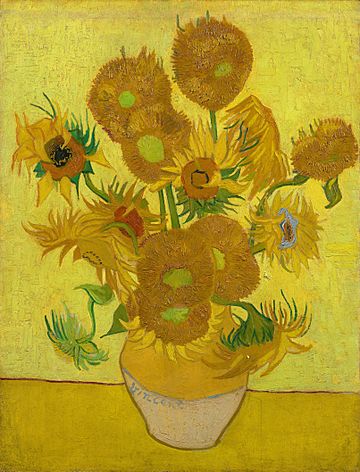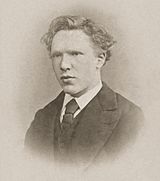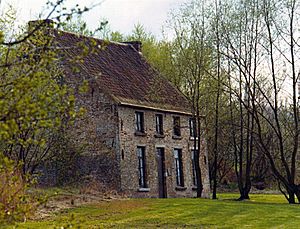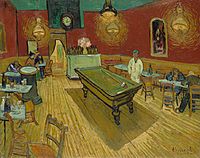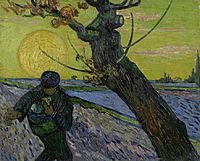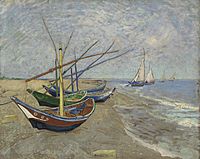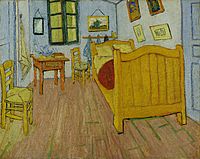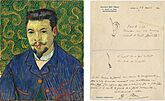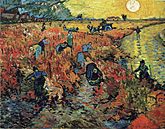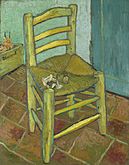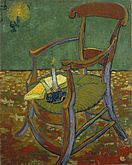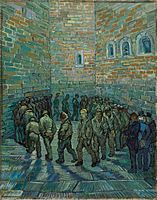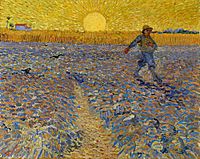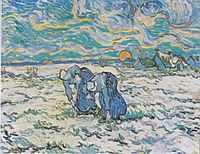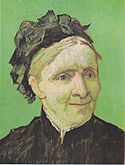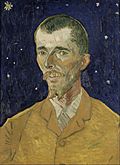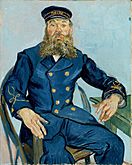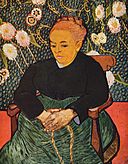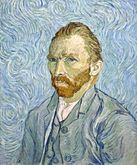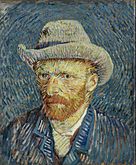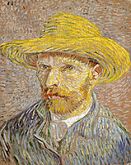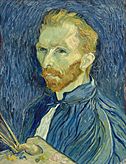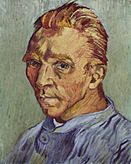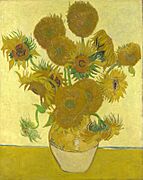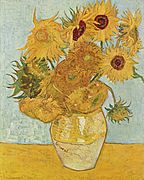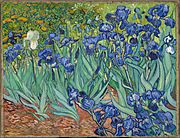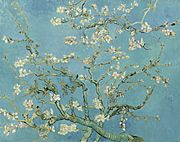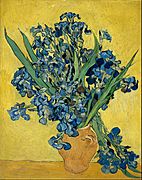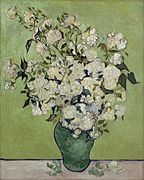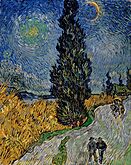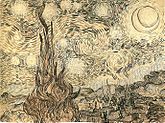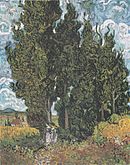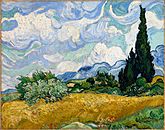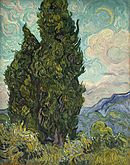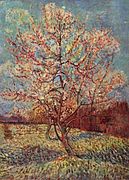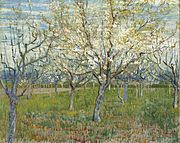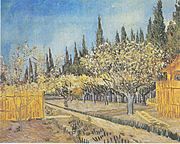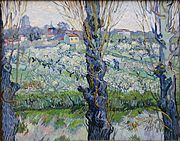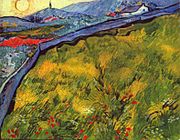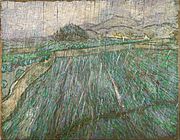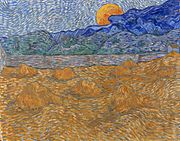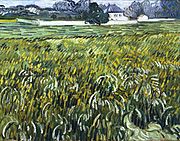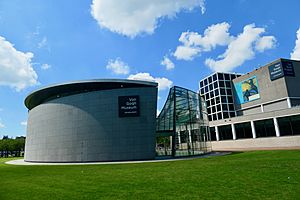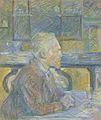Vincent van Gogh facts for kids
Quick facts for kids
Vincent van Gogh
|
|
|---|---|
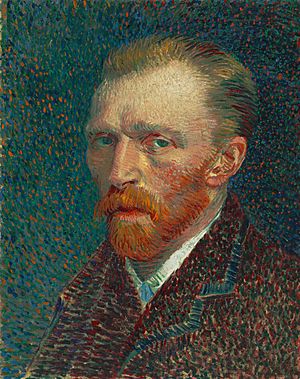
Self-Portrait, 1887, Art Institute of Chicago
|
|
| Born |
Vincent Willem van Gogh
March 30, 1853 Zundert, Netherlands
|
| Died | July 29, 1890 (aged 37) Auvers-sur-Oise, France
|
| Education |
|
|
Notable work
|
|
| Movement | Post-Impressionism |
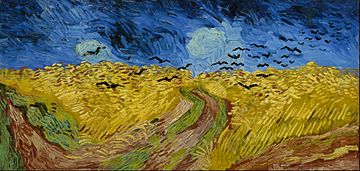
Vincent Willem van Gogh (March 30, 1853 – July 29, 1890) was a famous Dutch Post-Impressionist painter. He became well-known only after his death. Vincent struggled with severe depression and poverty throughout his life. He died young, at 37 years old, in 1890. Today, he is seen as one of the most important artists in Western art history.
Contents
- Vincent van Gogh's Early Life
- Vincent van Gogh's First Jobs
- Vincent van Gogh's Art Training
- Vincent van Gogh's Artistic Breakthrough
- Vincent van Gogh and Paul Gauguin
- Vincent van Gogh's Health and Fame
- Vincent van Gogh's Death
- Vincent van Gogh's Personal Life
- Famous Quotes by Vincent van Gogh
- Interesting Facts About Vincent van Gogh
- Vincent van Gogh's Major Art Series
- The Van Gogh Museum
- Images for kids
- See Also
Vincent van Gogh's Early Life
Vincent Willem van Gogh was born on March 30, 1853. His birthplace was Groot-Zundert in the Netherlands. He was the oldest child of Theodorus van Gogh, a minister, and Anna Cornelia Carbentus.
Vincent's parents married in 1851. His father did not earn much money. However, the church provided their family with a house, staff, and a carriage. This gave them a high social standing. Vincent had two brothers and three sisters. He stayed close with his sister Willemina ("Wil") and his brother Theo.
Vincent was a serious and thoughtful child. He loved art from a young age. His mother encouraged him to draw. He went to village school in 1860. Later, he attended boarding school and middle school. He felt unhappy at these schools.
Vincent van Gogh's First Jobs
In March 1868, van Gogh returned home. His uncle Cent helped him get a job at an art dealer. This company was called Goupil & Cie in The Hague. After training, Vincent moved to Goupil's London office in 1873. This was a happy time for him. He was good at his job and earned more than his father.
Before becoming a professional artist, van Gogh tried different jobs. He worked as a teacher in Ramsgate. He also helped a Methodist minister. He even wanted to become a pastor. In 1878, he tried to pass a theology exam for the University of Amsterdam but failed.
In January 1879, he became a missionary. He worked in a coal-mining area in Belgium called Borinage. To show support for the poor people there, he gave up his comfortable room. He moved into a small hut and slept on straw. His parents worried about him.
Vincent van Gogh's Art Training
In 1880, his brother Theo told him to take art seriously. At 27, Vincent joined the Académie Royale des Beaux-Arts. There, he studied how to draw the human body and use perspective. He continued his art education in 1886. He went to the Academy of Fine Arts in Antwerp.
His teachers in Antwerp did not like his unique painting style. He left the academy after getting sick. He was tired from overwork, poor food, and too much smoking.
Vincent van Gogh's Artistic Breakthrough
In February 1888, van Gogh moved to Arles, France. He loved the countryside and the bright light there. His paintings from this time use lots of yellow, blue, and purple colors. They show harvests, wheat fields, and other country scenes. One famous painting is The Old Mill (1888). He created 200 paintings and over 100 drawings in Arles.
On May 1, 1888, he rented a part of the Yellow House. He wanted a place to show his art. He started a series of paintings to decorate the Yellow House. These included Van Gogh's Chair (1888) and Bedroom in Arles (1888). Other works were The Night Café (1888) and Still Life: Vase with Twelve Sunflowers (1888).
-
The Old Mill, 1888. Albright–Knox Art Gallery, Buffalo, New York
Vincent van Gogh and Paul Gauguin

While living in Paris from 1886 to 1888, van Gogh met many Impressionist artists. One of them was Paul Gauguin. Van Gogh invited Gauguin to live and work with him in Arles. Vincent looked up to Gauguin and wanted to be seen as his equal. However, Gauguin was often proud and bossy, which upset van Gogh. Their friendship began to get worse, and they often argued.
After one argument, van Gogh's left ear was injured. Some art experts believe van Gogh hurt himself. Others think Gauguin was responsible. A policeman found van Gogh the next morning. He was taken to the hospital. The doctor could not reattach his ear because too much time had passed. Gauguin left Arles and never saw van Gogh again. However, they still wrote letters to each other.
-
Portrait of Félix Rey, January 1889, Pushkin Museum; note written by Dr Rey for novelist Irving Stone with sketches of the damage to van Gogh's ear
-
The Red Vineyard, November 1888. Pushkin Museum, Moscow. Sold to Anna Boch, 1890
-
Van Gogh's Chair, 1888. National Gallery, London
Vincent van Gogh's Health and Fame
Van Gogh often did not take care of his physical health. He suffered from mental health challenges, including psychotic episodes and delusions. After the ear incident, he spent time in psychiatric hospitals, including one in Saint-Rémy. He was allowed short walks under supervision. During these walks, he painted cypress trees and olive trees. He also painted the hospital's rooms and gardens. Some of his paintings from this time, like The Starry Night, have swirling patterns. In September 1889, he painted two more versions of Bedroom in Arles.
From March 20 to April 27, 1890, van Gogh showed ten paintings. They were part of an exhibition in Paris. The famous artist Claude Monet said van Gogh's work was the best in the show.
-
The Sower (after Jean-François Millet), 1888. Kröller-Müller Museum, Otterlo
-
Two Peasant Women Digging in a Snow-Covered Field at Sunset (after Jean-François Millet), 1890. Foundation E.G. Bührle Collection, Zurich, Switzerland
Vincent van Gogh's Death
In May 1890, van Gogh left the clinic in Saint-Rémy. He moved closer to his brother Theo and Dr. Paul Gachet. Dr. Gachet was a doctor who also painted. He had treated other artists.
Vincent's depression continued. On July 27, 1890, he was badly injured. He died from his injuries two days later. He was buried on July 30 in Auvers-sur-Oise.
Vincent van Gogh's Personal Life
Van Gogh asked several women to marry him, but they all said no. He was unlucky in love. He never married or had children.
Famous Quotes by Vincent van Gogh
- “It is good to love many things, for therein lies the true strength, and whosoever loves much performs much, and can accomplish much, and what is done in love is well done.”
- “I dream my painting and I paint my dream.”
- “A great fire burns within me, but no one stops to warm themselves at it, and passers-by only see a wisp of smoke.”
- “Normality is a paved road: It’s comfortable to walk, but no flowers grow on it.”
- “What would life be if we had no courage to attempt anything?”
Interesting Facts About Vincent van Gogh
- Van Gogh was named after his grandfather. He also had a brother with the same name who died at birth exactly one year before Vincent was born.
- His grandfather was a well-known art dealer.
- In just ten years, Vincent created about 2,100 artworks. This includes around 860 oil paintings. Most of these were made in the last two years of his life.
- He sold only one painting while he was alive. It was The Red Vineyard. It sold for 400 francs in Belgium, seven months before he died.
- The Starry Night, his most famous work, was painted while he was in a hospital in Saint-Remy-de-Provence, France.
- Van Gogh wrote almost 800 letters in his life. Most were to his brother and best friend, Theo.
- Theo van Gogh was an art dealer. He gave his brother money and emotional support. He also helped Vincent meet important people in the art world.
- Theo named his son Vincent, after his brother.
- Theo’s wife worked hard to collect her brother-in-law’s art. Thanks to her, van Gogh's work started to become famous 11 years after his death.
- A small planet, 4457 van Gogh, is named in his honor.
Vincent van Gogh's Major Art Series
Van Gogh loved to paint the beautiful nature around him. Here are some of the types of art he created.
Portraits by Vincent van Gogh
Van Gogh said he was most interested in painting portraits of people.
-
L'Arlésienne: Madame Ginoux with Books, November 1888. Metropolitan Museum of Art, New York
-
Portrait of Artist's Mother, October 1888, Norton Simon Museum of Art, Pasadena, California
-
Eugène Boch (The Poet Against a Starry Sky), 1888, Musée d'Orsay, Paris
-
Portrait of the Postman Joseph Roulin (1841–1903), early August 1888, Museum of Fine Arts, Boston
Vincent van Gogh's Self-Portraits
Van Gogh painted more than 43 self-portraits. He made these between 1885 and 1889. They were usually done in groups. His self-portraits have different styles. Sometimes, he painted himself by looking in a mirror.
-
Self-Portrait, September 1889. Musée d'Orsay
-
Self-Portrait, 1889. National Gallery of Art, Washington, D.C. His Saint-Rémy self-portraits show his side with the unmutilated ear, as he saw himself in the mirror
Vincent van Gogh's Flower Paintings
Van Gogh painted many landscapes with flowers. These included roses, lilacs, irises, and sunflowers. His most famous flower paintings are of sunflowers.
-
Still Life: Vase with Fourteen Sunflowers, August 1888. National Gallery, London
Cypresses and Olives in Van Gogh's Art
He became very interested in cypress trees. This happened while he lived in Arles. When he was in Saint-Rémy, van Gogh spent time outside the hospital. There, he painted trees in the olive groves.
-
Cypresses in Starry Night, a reed pen drawing executed by Van Gogh after the painting in 1889.
Vincent van Gogh's Orchards
The Flowering Orchards are among the first paintings van Gogh made after arriving in Arles in February 1888. There are 14 paintings in this group. They show a hopeful and joyful feeling of spring.
Vincent van Gogh's Wheat Fields
Van Gogh went outside the city of Arles to paint harvests. He was fascinated by wheat fields. He painted many scenes of them.
-
Rain or Enclosed Wheat Field in the Rain, November 1889, Philadelphia Museum of Art, Philadelphia
-
Wheat Field at Auvers with White House, June 1890, The Phillips Collection, Washington D.C.
The Van Gogh Museum
Van Gogh's nephew, also named Vincent Willem van Gogh, started working on a museum in 1963. The Van Gogh Museum opened in Amsterdam in 1973. It became the second most popular museum in the Netherlands. It gets over 1.5 million visitors each year. In 2015, it had a record 1.9 million visitors. Most visitors come from other countries.
Images for kids
-
The Potato Eaters, 1885. Van Gogh Museum, Amsterdam
-
Peasant Woman Digging, or Woman with a Spade, Seen from Behind, 1885. Art Gallery of Ontario, Toronto
-
Henri de Toulouse-Lautrec, Portrait of Vincent van Gogh, 1887, pastel drawing, Van Gogh Museum, Amsterdam
-
John Russell drew these five studies of Van Gogh a year or so after painting his 1886 portrait (studies, Art Gallery of New South Wales, Sydney)
-
Le Moulin de Blute-Fin (1886) from the Le Moulin de la Galette and Montmartre series'. Bridgestone Museum of Art, Tokyo (F273)
See Also
 In Spanish: Vincent van Gogh para niños
In Spanish: Vincent van Gogh para niños


